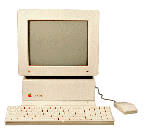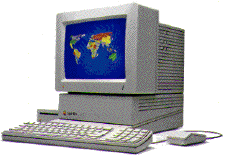The Apple IIGS home computer
(1986)
 The
computer you are looking at is the Apple IIGS,
one of the most revolutionary home computers known (and to many still
unknown) to the world. Even though this computer is over 13 years old
(introduced by Apple to the consumer on September 15, 1986), it can
still render complex three-dimensional images, create presentations
and animations, turn lights on and off and adjust the temperature in
your house, play full-screen full-motion three-dimensional
first-person-oriented games like Wolfenstein
3D, and even browse the World Wide Web. Its primary 16-bit
operating system, GS/OS, uses a graphical user interface that is very
similar to the Macintosh desktop metaphor. It even has its own
Unix-based operating system!
The
computer you are looking at is the Apple IIGS,
one of the most revolutionary home computers known (and to many still
unknown) to the world. Even though this computer is over 13 years old
(introduced by Apple to the consumer on September 15, 1986), it can
still render complex three-dimensional images, create presentations
and animations, turn lights on and off and adjust the temperature in
your house, play full-screen full-motion three-dimensional
first-person-oriented games like Wolfenstein
3D, and even browse the World Wide Web. Its primary 16-bit
operating system, GS/OS, uses a graphical user interface that is very
similar to the Macintosh desktop metaphor. It even has its own
Unix-based operating system!
The Apple IIGS is built around a
2.8-megahertz 65c816 16-bit processor, upgradeable to 15 MHz or
faster and 64 KB of L2 cache with customized accelerator cards. That
may not sound fast to you, but with this particular processor and the
light overhead of its operating environment, it FLIES! This computer
sports 4-bit graphics and full stereo 8-bit sound, both of which were
unheard of in 1986! The IIGS is a rival to the
Amiga in terms of graphics capability (it can display all Apple II
resolutions plus two "super hi-res" resolutions, 320x200 pixels and
640x400 pixels, with a maximum of 3200 colors onscreen at any given
time), and a rival to high-end music sythesizers of its time with a
32-channel (usually in 16 stereo voices) stereo Ensoniq 5503 DOC
sound chip. (Ensoniq Corp. has now been acquired by Creative Labs,
the makers of the Sound Blaster series of sound cards for
IBM-compatibles.) It also has full backward compatibility with all earlier Apple II models, meaning it can run
software AND use hardware designed for earlier Apple II models. The
Apple IIGS offers expandability beyond many
modern computers. It has seven expansion slots to add new interface
cards, and a card has been designed for nearly every task. But the
abilities of this computer are not something that can be easily
transcribed; the only way to find the true magic of the system is to
experience it. If you can appreciate vintage computer systems, this
computer will amaze you with all of its shocking capabilities!
compatibility with all earlier Apple II models, meaning it can run
software AND use hardware designed for earlier Apple II models. The
Apple IIGS offers expandability beyond many
modern computers. It has seven expansion slots to add new interface
cards, and a card has been designed for nearly every task. But the
abilities of this computer are not something that can be easily
transcribed; the only way to find the true magic of the system is to
experience it. If you can appreciate vintage computer systems, this
computer will amaze you with all of its shocking capabilities!
I personally own a ROM 3 Apple IIGS with 3
MB of RAM, a TransWarp GS accelerator, a Sonic Blaster GS sound
output enhancement and input sampling card, an Apple II High Speed
SCSI Card and a 500 MB hard drive, a Gibson Light Pen, and tons of
software.
For a little background on the Apple IIGS
and some of its specifications
and little-known trivia, click here.
For more information on this awesome computer and other Apple II
computers and compatibles, visit the links below.
If you are new to the world of Apple II computers, I suggest you
start by reading the official
FAQ files. A GREAT source of information on Apple II computers is
the Apple II
Webring. Another great place for news and information on Apple
II's is Apple2.org. If you have
access to USENET Newsgroups, drop by any of the groups in the
comp.sys.apple2*
hierarchy and ask some questions. Be sure first though that you
have searched the FAQs for your question before you ask it in the
newsgroup.
More links follow:
The
A2-Web
Apple II
Sites and Searches
Apple II info
page
Apple II
History
It All Began With
Apple
Spectrum Internet
Suite (Web browser for Apple IIGS!)
Wolfenstein
3D for IIGS (IIGS
version of the popular game!)
Apple II newsgroup
Some companies that still
support the Apple II line:
Seven Hills
Software
Sequential Systems
///SHH
Systeme
Shareware Solutions
II
Alltech Electronics
The Byte Works
(Apple II software)
 The
computer you are looking at is the Apple IIGS,
one of the most revolutionary home computers known (and to many still
unknown) to the world. Even though this computer is over 13 years old
(introduced by Apple to the consumer on September 15, 1986), it can
still render complex three-dimensional images, create presentations
and animations, turn lights on and off and adjust the temperature in
your house, play full-screen full-motion three-dimensional
first-person-oriented games like Wolfenstein
3D, and even browse the World Wide Web. Its primary 16-bit
operating system, GS/OS, uses a graphical user interface that is very
similar to the Macintosh desktop metaphor. It even has its own
Unix-based operating system!
The
computer you are looking at is the Apple IIGS,
one of the most revolutionary home computers known (and to many still
unknown) to the world. Even though this computer is over 13 years old
(introduced by Apple to the consumer on September 15, 1986), it can
still render complex three-dimensional images, create presentations
and animations, turn lights on and off and adjust the temperature in
your house, play full-screen full-motion three-dimensional
first-person-oriented games like Wolfenstein
3D, and even browse the World Wide Web. Its primary 16-bit
operating system, GS/OS, uses a graphical user interface that is very
similar to the Macintosh desktop metaphor. It even has its own
Unix-based operating system! compatibility with all earlier Apple II models, meaning it can run
software AND use hardware designed for earlier Apple II models. The
Apple IIGS offers expandability beyond many
modern computers. It has seven expansion slots to add new interface
cards, and a card has been designed for nearly every task. But the
abilities of this computer are not something that can be easily
transcribed; the only way to find the true magic of the system is to
experience it. If you can appreciate vintage computer systems, this
computer will amaze you with all of its shocking capabilities!
compatibility with all earlier Apple II models, meaning it can run
software AND use hardware designed for earlier Apple II models. The
Apple IIGS offers expandability beyond many
modern computers. It has seven expansion slots to add new interface
cards, and a card has been designed for nearly every task. But the
abilities of this computer are not something that can be easily
transcribed; the only way to find the true magic of the system is to
experience it. If you can appreciate vintage computer systems, this
computer will amaze you with all of its shocking capabilities!